STORIES OF A MERCHANT SAILOR
Part Two
CHRISTMAS IN AMERICA
by Gordon Sollors
The British Faith was my second ship. I had been a Deck Boy on the previous ship,
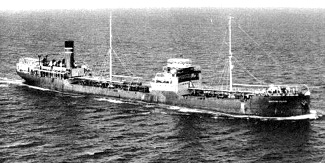
|
Birkenhead Docks in November is a cheerless place, or so it seemed to me at that time. The ship was high out of the water, I lugged my case and kit bag up the gangway, and on to the after deck. As it happened, the first person I spoke to was the Bosun, he directed me to the Seamen's Fo'c'sle, which was on the starboard side for'ard.
When I entered the fo'c'sle, there were other crew members already there. I soon had my duties spelled out to me. I was to be the Seamen's "Peggy". My primary duties were to bring the food from the galley, wash up the dishes, and to keep the messroom and fo'c's'le in a clean condition at all times. I was directed to the bunk which was to be mine. No choice, just "That's your bunk kid". It was the top bunk, furthest for'ard, on the outboard side of the fo'c'sle, and next to a porthole.
We left Birkenhead that evening, the ship took in ballast, to put us lower in the water. For docking purposes, my station was aft. I was to appreciate this later. Being winter, it was always cold, but whilst waiting for the ship to maneuver alongside, we could stand in the engine room fidley, which was always nice and warm.
It was whilst stood in the doorway that I learned that a motor ship is actually started with a blast of compressed air. When the telegraph rang, there would be a huge belch of compressed air, which I suppose overcomes the inertia of the propeller until the diesel combustion process takes over. Then the tall, slotted air intakes - one to each cylinder - would shake and rattle until the propeller shaft was turning smoothly. I was fascinated.
We made our way from the River Mersey, to the River Clyde, where we waited for other ships with which we would form a convoy. I think we stayed in the Clyde for a few days, during which time the sailors erected huge wind sails in some of the tanks to ventilate them. One sailor tried to tell me that these were used sometimes as a means of helping the ship along in order to conserve fuel! He didn't fool me. I knew they couldn't work whilst we had the anchor down!
Eventually we got under way, and out into the North Atlantic. Word soon spread that New York was to be our destination. I was elated. At last I would see all those wonderful sights we saw in the pictures, and hear real Americans speak!
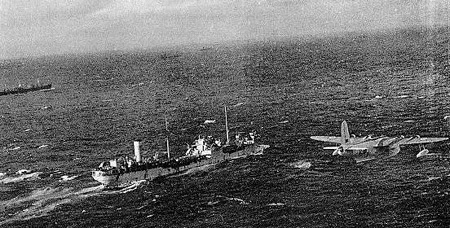
|
This photo shows the tanker British Faith in convoy somewhere off Britain. The convoy is being shepherded by a Short Sunderland Flying Boat operated by Britain's RAF Coastal Command. |
|
This photo is courtesy of Dennis Sandford, who was serving aboard British Faith's sister ship MV British Advocate when she was captured by the German pocket battleship, Admiral Scheer, on February 20, 1941. Dennis spent the next 4 years in a POW camp, and after the war he became Chief-Officer aboard British Faith . He now lives in Queensland, Australia. |
|
For the first week out from the U.K., whilst we were still within range of air attack, ALL deck department personnel, had to do a gun watch. This included even me! We had D.E.M.S. gunners aboard, but they were just not enough to man all the guns all of the time. Again, I was quite excited, and saw myself shooting them down like flies. An hour on watch in the freezing gun pit soon put paid to those images!
For my first watch, I was put in a pit with a single gun which really looked no more than a Lee Enfield rifle mounted on a pole with some armour plate just big enough to cover me as I stood. From memory, I was told it was a Hotchkiss gun. I had never heard of them before - nor since! Readers should be aware that this was 1942, and there were still ships which had not yet been fitted with the more up to date Oerlikon gun which was to become the standard. The gunner showed me what to do to fire the gun. It had a bolt action which could be set for either single shots or `rapid fire'. The bullets were contained in a brass belt, with a hinge at about every third bullet. The gunner told me that should the gun jamb, I should let it go, and make myself as small as possible in the gun pit!
The next gun pit I was allocated to contained guns just as ancient. This one had twin guns mounted on a swivel. I think they were Vickers or Browning. They had fluted barrels with what I thought were water cooling hoses attached. I only spent one watch on these, then it was back to the Hotchkiss.
With the poor weather, it was almost impossible to walk around the gun pit to keep warm. I was frozen stiff for most of the time. I doubt whether my fingers could have fired the gun had it been necessary! After one week of this, the thought of a return to messroom duties seemed almost erotic by comparison. We kept the same vigil on our return journey.
After about three weeks of constant movement, I awoke one morning to that eerie silence which is the difference from being at sea, to being in port. I hadn't even woke up when the anchor went down! I almost fell out of my bunk, got speedily dressed, and went out to have a look. It was still dark - it was about 6.45 AM. But there it was, the Great City itself! There was a tender alongside, and I could hear real American accents! Boy, this was really living! In my pitifully naive imagination, I could see Clark Gable, Joan Crawford, Betty Grable et. al. walking down Broadway, smiling at all and sundry - myself among the sundry.
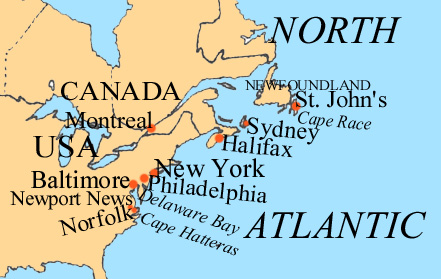
|
As it happened, it wasn't the Germans who put our nose out of joint, we successfully grounded the ship in Delaware Bay. This was fortuitous, because it meant that instead of going to Marcus Hook in Philadelphia as planned, we had to go hard a port into a canal which took us to Baltimore, where the ship had to be dry docked for inspection. Since Christmas was only a week or so away, no one had any arguments with that!
We tied up at the huge Bethlehem Steel Shipyards, where Liberty ships were turned out by the dozen. We could see all the ship parts lying on the shore, all ready for installation on the next ship. There were rudder posts, rudders, anchors and propellers by the dozen. Miles of anchor chain, all laid out, and ready to be hauled aboard the next ship.
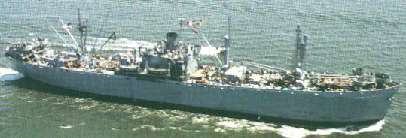
|
This is the SS John W. Brown, which along with the SS Jeremiah O'Brien, is one of the only two surviving Liberty Ships. John W. Brown was built by the Bethlehem- Fairfield Shipyard of Baltimore, in September 1942. |
The photo is from the SS John W. Brown Project Liberty Ship website. |
|
In Gordon's next story, Steering Lessons, he writes about the Liberty Ship, SS Frank A. Vanderlip. She had the unusual distinction of having her British name, Sambuff, changed back to her original American name. |
|
My first night ashore almost turned into a disaster. In keeping with my naivety with all things American, I wanted a Ronson Cigarette Lighter. Well, Spencer Tracy used them, and that was good enough for me! At that time, the English pound was worth four American dollars, and a few cents. I had drawn out two pounds ten, which gave me just over ten dollars. Move over Rupert Murdoch!
I went ashore with the Ordinary Seaman. At sixteen, he was a year older than I. We walked along the silent quayside, knee deep in snow. The guard on the gate was most cheery. At that time, English people were `flavour of the month' over there. What with the blitz, and everything. In fact, had we known, pieces of bomb shrapnel which were common enough in England, were selling for about $5 in the U.S. If one was lucky enough to have a piece (which hadn't actually killed one!) with German writing on, then the price was considerably higher!
We were hardly out of the gates when a hearty voice called over "Hi there you guys, wannalift?" Did we ever! He had a big black car, and we were invited to `jump in' The conversation was full of praise for the war effort, he was constantly telling us how brave the Brits were. Before long, he pulled up in a brightly lit street, and opened the door for us. "Most of your guys come here for their clothes when they come ashore" he said indicating a large shop. Not wishing to be discourteous we followed him in.
Then the `Big Sell' began. Not that the stuff was rubbish, far from it. It was just that, well, we really hadn't intended buying those things at this time! He had (Levi) dungarees with rivets and triple stitching at a dollar (five bob) a pair. (Anything up to $100 these days!) The price was not all that much different from U.K., but they were the REAL THING, i.e., American!! We were, as they say, putty in his hands. About fifteen minutes later, we left the shop, each with a large parcel, and MUCH lighter pockets. We hadn't been robbed, we hadn't been cheated, all the clothes were of excellent quality. We had been maneuvered. It was just that almost without our realising it, our priorities had been changed for us. I think we had a couple of dollars each left, so we had a cup of coffee and a doughnut each, then found our way back to the ship.
The ship was `run down' ready for dry docking. We had no heat, or light, and the condensation in the fo'c'sle turned to ice on the bulkheads. We had to sleep fully dressed! Later we were sent ashore, and put up in the Biltmore Hotel. Undreamed of luxury!! Taffy, (the Ordinary Seaman) and myself were a little bit more cagey when we went `ashore' from the hotel. We went to the Missions to Seamen where we were given a wonderful meal for a few cents. A lady came from the office, and offered us free cinema tickets. The Americans really couldn't do enough for us. On Christmas Day, through the Missions to Seamen, we were invited to dinner with a couple who had two children and lived on the outskirts of Baltimore. We were even given free tram tickets to get there. The people were kindness itself, but on reflection, I think they were expecting two older `men' who possibly, could have provided a more mature conversation than we were capable of. As it was, Taffy and I were only a few years older than their own children, and we paid rather more attention to watching our `P's and `Q's than trying to make interesting conversation. Our hosts were exceptionally nice, and had wrapped a small gift each for us. I had a small wallet and a carton of `Lucky Strike' cigarettes (I wasn't legally old enough to smoke!) Sadly, I lost the wallet some time later, and in it the address of the people who treated us so kindly that Christmas.
We eventually loaded up at Philadelphia and made our way out to the Atlantic where we joined a convoy bound for England. After about three weeks in America, there were several things which I had grown to like. Commercial radio (practically unheard of in England at that time) was not one of them. We were not allowed radios in our quarters, so we were dependent upon the Radio Operator tuning in the ship's radio. As the miles between us and the U.S.A. increased, so mercifully the blare of commercial radio decreased, and the sanity of the BBC News and Forces Favourites took over again!
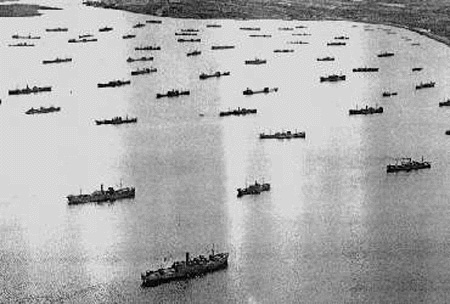
|
Before the United States entered the war, Halifax, Nova Scotia , with its spacious harbour, Bedford Basin, was the main assembly port for the North Atlantic convoys to Britain. This photo shows a convoy in Bedford Basin being readied for sailing. |
This photo is from A Nation Forged in Fire: Canadians & the Second World War 1939-1945, by J.L. Granatstein & Desmond Morton. Toronto: Lester & Orpen Dennys, 1989. |
We arrived in Swansea without incident in early February. I tried my best not to speak with an American accent when we went ashore, but then, with accents like one hears in Wales, who would have known the difference?
| Please Click Here to read Gordon's next story, Steering Lessons. |
| Please Click Here to return to Gordon's first story, The Peggy. |
| TABLE of CONTENTS |
| INDEX PAGE |
Gordon's pages are maintained by Maureen Venzi and are part of The Allied Merchant Navy of World War Two website.